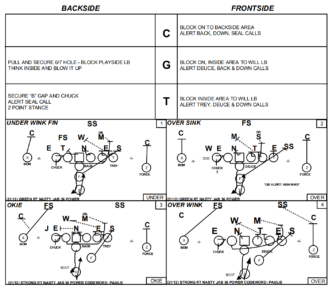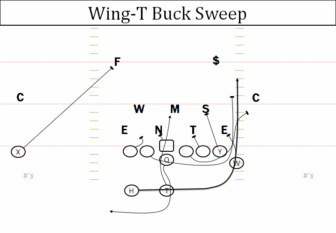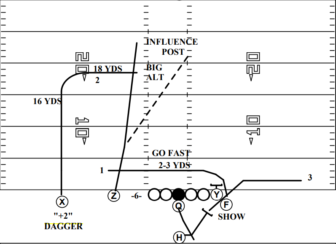
Trap is an aggressive and quick hitting play with pulling linemen. Different from power and counter, it targets interior defenders instead with trap blocks. Trap hits fast and needs to be timed well with narrow running lanes for the running back down the middle of the defense.
Power
Trap Philosophy
With a shorter distance to pull, trap is a fast play that intentionally leaves an interior defensive lineman unblocked. That defensive tackle then gets “trapped” by the pulling backside guard. Leaving the defensive tackle unblocked allows for an interior offensive lineman to immediately climb to the second level. It also exposes interior defenders to different looks and blocks. It slows down their disruptiveness and gets the offense a numbers advantage in the middle of the defense.

Buck Sweep
Trap Assignments
There are multiple variations of trap. Fronts and alignments can change which linemen is climbing to the second level. Trap can also be run with the “trapper” being a fullback, H-back, or even a receiver.
There are two general variations of Trap: short Trap (two gaps) and long trap (three gaps). Most Trap schemes operate with the guard pulling. For this article, we’ll focus on short traps with guards.
Running Back:
- Run a counter track by taking the handoff from the direction of the pulling lineman
- Aim for backside leg of center
- Ride the inside hip of the backside guard and influence the defense to the backside of the play with counter track
Offensive Line:
- Play-side Tackle (PST)
- Step inside and protect inside gap
- Must not let defensive end chase down line of scrimmage
- After protecting inside, climb to linebacker backside
- Play-side Guard (PSG)
- Down-blocking anyone in backside gap
- If no defender is present, climb to the first linebacker to the backside
- Down-blocking anyone in backside gap
- Center
- Responsible for down-blocking anyone in their backside gap
- If no defender is present, they will climb to the first linebacker to the backside.
- Responsible for down-blocking anyone in their backside gap
- Backside Guard (BSG)
- Pivot step and point toe directly at the inside shoulder of the defender that is being trapped
- Trap defender is the first defender play-side of the center
- Angle of pull must be tight to the line of scrimmage, if not downfield
- Replace center’s heels
- Pivot step and point toe directly at the inside shoulder of the defender that is being trapped
- Backside Tackle (BST)
- Step inside and protect inside gap
- Must not let defensive end chase down line of scrimmage
- After protecting inside, climb to linebacker backside
Examples
The Browns do a great job with the details on this Trap play against Washington. Often, teams like to run Trap at 3-techniques and off of jet sweep motions. The pre-snap motion moves players away from the play and sells outside run to force defenders to chase that direction. The Trap play then comes underneath.
Sail Concept
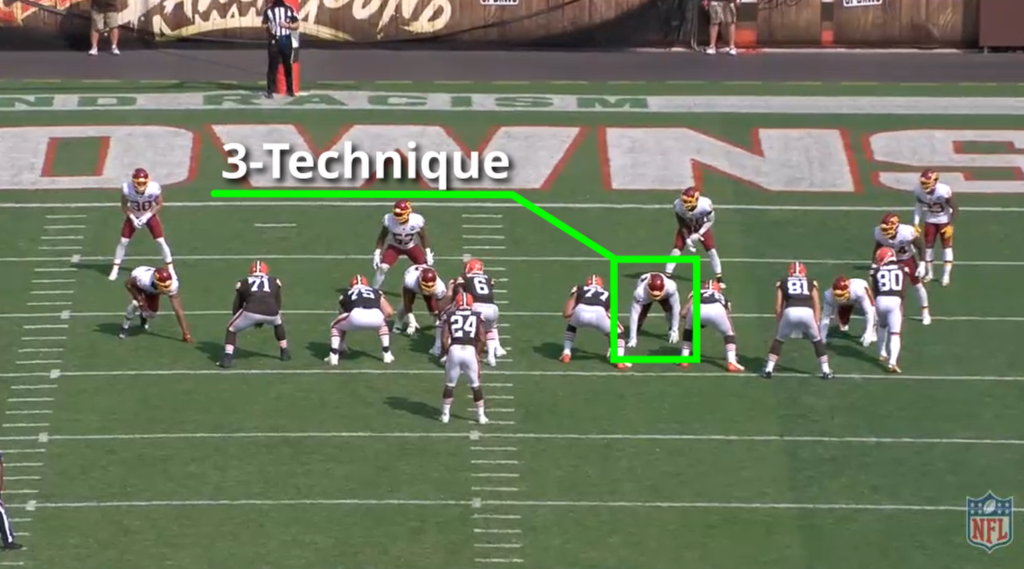
On the play-side, the tackle swims the 3-technique on his way to the middle linebacker. Since the Browns have a wing, that player is now responsible for protecting the inside gap which frees the tackle to climb. The play-side guard does a great job of giving a quick bluff to the 3-technique to help hold them in place for the backside guard to trap. That same play-side guard then climbs to the first linebacker backside. The center down-blocks the backside defensive tackle, and the BST pinches and protects inside against the defensive end. Chubb gets the handoff on the left side and rides the trapping guard to the play-side hole on the right. Since the play is so quick-hitting, outside defenders don’t need to be blocked as long as the interior defenders are taken care of. The PST is able to get a piece of the middle linebacker and the Browns pick up five yards.
This Colts play is a great example of the trapping guard aiming for the downfield shoulder and staying tight to the line of scrimmage. The PSG again gives a bluff to the 3-technique to hold them and climbs to the backside linebacker to prevent pursuit. The center down-blocks on the 1-tech to the other side. The running back rides the inside hip of the trapping BSG for a gain of eight yards.
Dagger Concept
Lastly, here is an example of the Rams and a 3-technique that does a really good job of squeezing down on the play when the PSG leaves to go to the second level. As he recognizes that he is going to be unblocked, he pinches down in the gap and doesn’t chase up-field. With the center unable to get significant push, that makes it harder for the BSG to pull and trap the 3-technique. Both offensive tackles immediately release up to the second level and Cam Akers is able to squeeze a few yards out of the play despite good technique from Dallas’ interior defenders.
Summary
Trap is a quick-hitting play that’s typically used as a change of pace of outside runs like Buck Sweep or Jet Sweep. It brings physicality, forces interior defenders to deal with a different kind of block, and quickly gets running backs up onto the second level.

